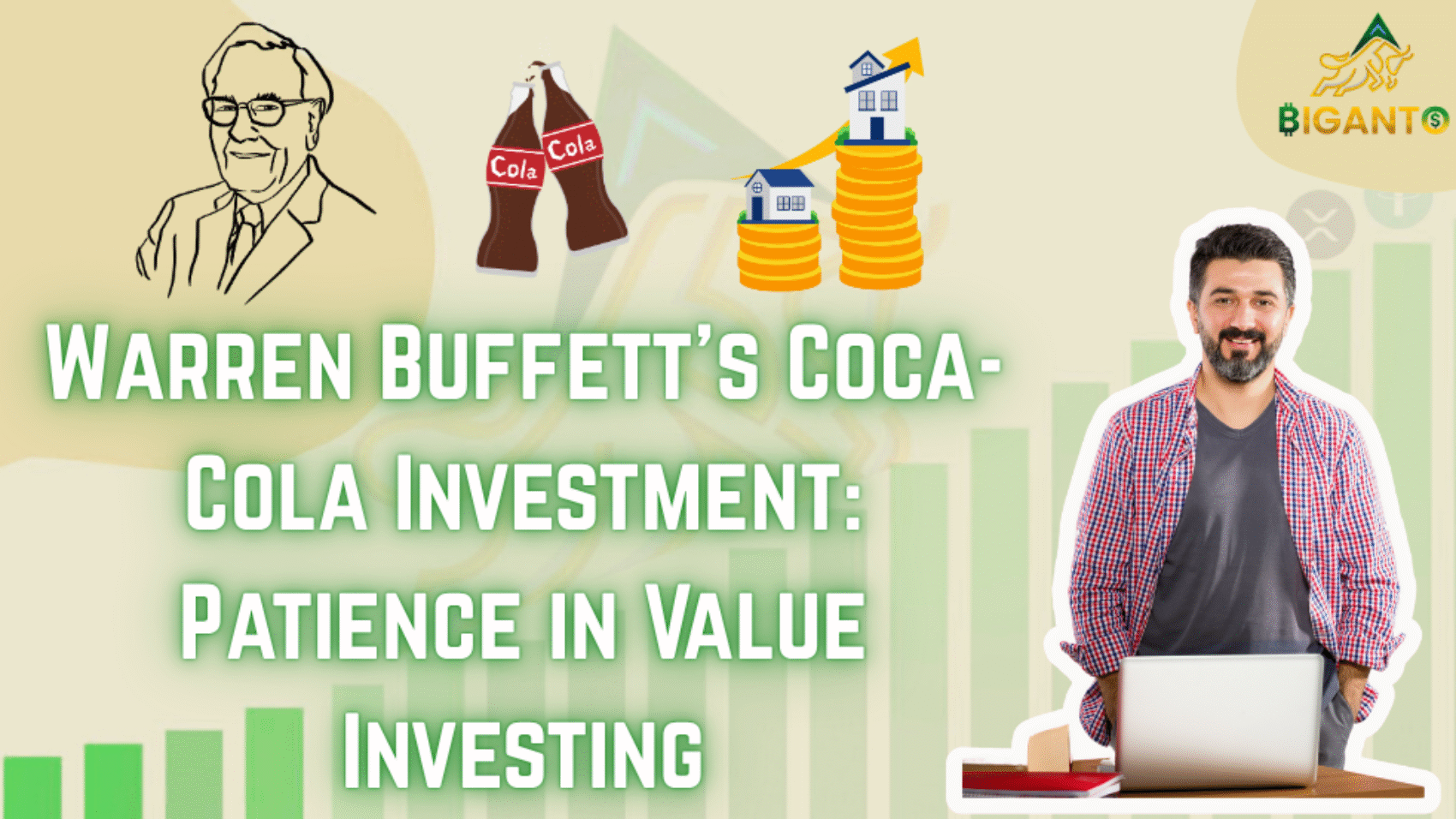When the late 1980s dawned, the investing world was still licking its wounds from a devastating blow the notorious Black Monday scare of October 1987, when markets fell off a cliff in one day. Panic spread through Wall Street. Many investors retreated, afraid of more wild swings. But for Warren Buffett, it was exactly the sort of environment that creates opportunity.
By 1988, Buffett started focusing on a company that most Americans were familiar with The Coca-Cola Company (ticker: KO). It was a well-known brand with a presence around the world and over a hundred years of history. However Coca Cola wasn’t without its problems. The 1980s began tough for the company. It was dealing with increased competition from Pepsi, changing tastes as people preferred healthier drinks, and a major public relations disaster called the “New Coke” incident, which is considered one of the worst marketing mistakes in business history.
But where other people saw problems, Buffett saw opportunities.
He paid attention to the important things and not just the temporary issues.
To him, Coca Cola was a business that would last forever with a strong brand, a wide reach around the world, and the ability to set prices that would hold up no matter what happened in the economy. It had what Buffett often talks about as a strong moat a big advantage that makes it hard for competitors to take away its profits for a long time.
What happened next became one of the best investment stories in history not because it was exciting or fast, but because it was based on sticking to the rules, keeping things simple, and being patient.
Buffett’s Rationale – Why Coca-Cola?
Buffett often says that Coca-Cola isn’t just a stock, but a company he really knows and likes.
In fact, when he said his famous line “Our favorite holding period is forever” it was about Coca-Cola, as he wrote in his 1988 letter to shareholders. It wasn’t just a general idea it was because he believed in Coca-Cola’s strong and lasting qualities.
Buffett has always stressed the importance of investing in businesses with a durable competitive advantage or what he calls an economic moat. Coca-Cola has one of the strongest moats in the world its brand power and global market dominance.
Another major reason Buffett was attracted to Coca-Cola was its ability to generate consistent earnings and return capital to shareholders through dividends. Unlike companies in volatile industries that experience sharp profit swings, Coca-Cola has been able to grow its earnings steadily for decades. For Buffett, dividend-paying stocks serve two key purposes:
1. They generate consistent cash flow that can be reinvested into other investments.
2. They demonstrate strong financial discipline, as only high quality businesses can sustain long-term dividend growth.
At the 2025 Berkshire Hathaway Annual Meeting, Buffett explained
“It’s always better to make a lot of money without putting up anything than it is to make a lot of money by putting up a lot of money. Coca-Cola’s concentrate business doesn’t require much capital. That’s what makes it a fabulous business.”
This shows one of his main ways of choosing investments: businesses that make a lot of money with little capital.
Coca-Cola focuses on make the drink mix and lets others handle the bottling. This setup means it doesn’t need a lot of money to grow, which helps it make money consistently.
Holding Through Market Fluctuations
Buffett stayed with Coca-Cola during some of the biggest ups and downs in the stock market:
Dot-Com Bubble (late 1990s): Tech stocks were doing really well, and older companies like Coca-Cola were seen as old-fashioned. During the exuberant technology boom of the late 1990s, more staid old-economy stocks were often overlooked in favor of flashy new internet firms promised unending growth. However, Buffett maintained his prudent philosophy anchoring investment selections to fundamentals rather than fleeting fashions.
Dot-Com Crash (2000–2002): When tech stocks fell sharply, Coca-Cola did better, showing how a strong, steady business can hold up during panic.
2008 Global Financial Crisis: Even though everyone was worried, Berkshire Hathaway didn’t sell Coca-Cola.
The company’s strong brand and steady cash flow made Buffett confident in its future.
Other Corrections & Dips: Coca Cola’s stock didn’t always go up.
There were long times when it performed worse than other stocks. But Buffett never doubted the company’s long-term potential.
Adapting to Business Challenges
Even a famous drink company like Coca Cola had to change and grow:
Shifting Consumer Preferences: As people started caring more about health, Coca-Cola expanded beyond sugary drinks buying brands like Minute Maid and Costa Coffee, and creating products like Coke Zero and sparkling water.
Rising Competition: New startups and changing tastes brought new challenges, but Coca Cola’s worldwide presence and smart marketing kept it in the lead.
Regulatory Pressure: With laws like sugar taxes and health regulations, the company had to act wisely and it did.
HOW THE INVESTMENT HAS PERFORMED
The Growth of Buffett’s Initial Investment
In 1988, Buffett started buying shares of The Coca-Cola Company.
Over the next few years, he bought around 400 million shares, spending a total of $1.3 billion.
At the time, Coca-Cola was already a well-known brand, but its stock was undervalued after the 1987 market crash. Buffett saw a golden opportunity.
Now, fast forward to today those same shares are worth over 25 billion dollar.
That is a return of nearly 2,000% just from the increase in share price alone.
And here’s the amazing part: Buffett never sold those shares. He just bought, held, and waited.
The real magic of this investment won’t just the price going up
it’s the steady income from dividends that Warren Buffett gets from Coca-Cola, and how much that income has grown over time.
Coca-Cola has raised its dividend every year since Buffett first invested.
Today, Berkshire Hathaway gets more than $700 million each year just from dividends alone from Coca Cola.And here’s the amazing part Buffett originally invested just $1. Now, he’s getting over 50% of that amount every year, without ever selling a single share!
This shows the power of compounding:
As Coca-Cola’s profits went up, it paid out more in dividends.
Buffett kept holding onto the stock, letting the money keep coming in year after year, decade after decade.
Buffett’s Patience Through Market Turbulence
Buffett’s ability to maintain his investment in Coca-Cola over decades of market manias, volatility, and shifting consumer tastes is among its most impressive features. Although the path wasn’t easy, it was patient.
Buffett’s Advice on Investing
Over the years, Buffett has conveyed his beliefs through some excellent and thought-provoking advice.
1. Hold on Then
when you locate a business that you want to invest in, Pounce Buffett suggests taking a deep breath and stepping back. He advises waiting for the stock to reach a fair price before acting when the market corrects.
2. Continue on the same path
After taking a breath and waiting, it’s time to take action. Buffett advises not panicking now and selling your stocks when they start to deteriorate, which they will eventually do. Avoid selling. Purchase.
He stated, Just keep buying, during an interview with CNBC. American business is going to do fine over time, so you know the investment universe is going to do very well.
3. Choose Companies Rather Than Stocks
Always, always consider and evaluate the company that owns a stock. Make an effort to concentrate on companies that you are familiar with and understand. This will assist you in evaluating a company’s direction rather than just its past and present. Having patience goes hand in hand with this tip. Educate yourself if you discover an attractive opportunity in a field that you’re not totally familiar with. Do a balance sheet analysis. Take time to learn.
Conclusion: The Influence of Perseverance
A timeless lesson in value investing can be learned from Warren Buffett’s Coca-Cola investment. He saw past the hubbub of the moment and concentrated on a wonderful company with a strong brand, steady profits, and little need for financing. Buffett increased his investment from $1.3 billion to over $25 billion by holding the company for decades without ever selling a single share.
What’s the true lesson? It pays to be patient. Compounding takes care of the rest when you purchase a solid business at a reasonable price and stick with it through fluctuations. Buffett’s Coca-Cola narrative demonstrates that, in the fast-paced market of today, sometimes the best course of action is to do nothing at all.
“Time is the friend of the wonderful business.” Warren Buffett

